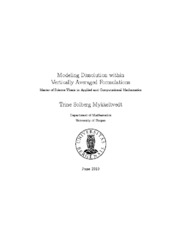Modeling Dissolution within Vertically Averaged Formulations
Master thesis
Permanent lenke
https://hdl.handle.net/1956/4209Utgivelsesdato
2010-06-10Metadata
Vis full innførselSamlinger
Sammendrag
In this thesis we develop a mathematical model describing the migration and trapping of CO2 when injecting it in a deep saline aquifer. Both the migration and trapping processes are inherently complex, spanning multiple spatial and temporal scales. We develop a upscaled mass transfer model for these processes within vertically averaged formulations. This model is applied to a benchmark problem designed to highlight important questions about the long term fate of the injected CO2. In the developed model the effect of dissolution trapping is included. When considering dissolution trapping we distinguish between dissolution due to equilibration between mobile CO2 and brine as CO2 drains a region with pure brine, and dissolution due to density driven convective mixing. Using the developed model we have studied the plume migration with and without the effect of convective mixing and looked at the influence the value of the dissolution rate has on the tip velocity. Our results shows that the value of the dissolution rate has a great impact on the tip velocity. We find that the tip velocity has two characteristic values depending on the dissolution rate.
Utgiver
The University of BergenOpphavsrett
The authorCopyright the author. All rights reserved
